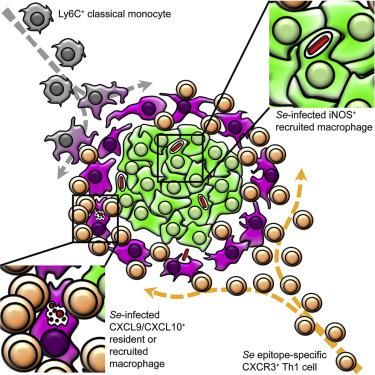Our official English website, www.x-mol.net, welcomes your feedback! (Note: you will need to create a separate account there.)
Salmonella Persist in Activated Macrophages in T Cell-Sparse Granulomas but Are Contained by Surrounding CXCR3 Ligand-Positioned Th1 Cells.
Immunity ( IF 32.4 ) Pub Date : 2018-12-11 , DOI: 10.1016/j.immuni.2018.10.009 Michael F Goldberg 1 , Elizabeth K Roeske 1 , Lauren N Ward 1 , Thomas Pengo 2 , Thamotharampillai Dileepan 1 , Dmitri I Kotov 1 , Marc K Jenkins 1
Immunity ( IF 32.4 ) Pub Date : 2018-12-11 , DOI: 10.1016/j.immuni.2018.10.009 Michael F Goldberg 1 , Elizabeth K Roeske 1 , Lauren N Ward 1 , Thomas Pengo 2 , Thamotharampillai Dileepan 1 , Dmitri I Kotov 1 , Marc K Jenkins 1
Affiliation

|
Salmonella enterica (Se) bacteria cause persistent intracellular infections while stimulating a robust interferon-γ-producing CD4+ T (Th1) cell response. We addressed this paradox of concomitant infection and immunity by tracking fluorescent Se organisms in mice. Se bacteria persisted in nitric oxide synthase (iNOS)-producing resident and recruited macrophages while inducing genes related to protection from nitric oxide. Se-infected cells occupied iNOS+ splenic granulomas that excluded T cells but were surrounded by mononuclear phagocytes producing the chemokines CXCL9 and CXCL10, and Se epitope-specific Th1 cells expressing CXCR3, the receptor for these chemokines. Blockade of CXCR3 inhibited Th1 occupancy of CXCL9/10-dense regions, reduced activation of the Th1 cells, and led to increased Se growth. Thus, intracellular Se bacteria survive in their hosts by counteracting toxic products of the innate immune response and by residing in T cell-sparse granulomas, away from abundant Th1 cells positioned via CXCR3 in a bordering region that act to limit infection.
中文翻译:

沙门氏菌持续存在于T细胞稀疏肉芽肿中的活化巨噬细胞中,但被周围的CXCR3配体定位的Th1细胞所包含。
肠沙门氏菌(Se)细菌会引起持续的细胞内感染,同时刺激产生强烈干扰素-的CD4 + T(Th1)细胞应答。我们通过追踪小鼠中的荧光硒生物体,解决了这种伴随感染和免疫的悖论。硒细菌在产生一氧化氮合酶(iNOS)的常驻和募集巨噬细胞中持续存在,同时诱导与一氧化氮保护相关的基因。硒感染的细胞占据了iNOS +脾肉芽肿,排除了T细胞,但被产生趋化因子CXCL9和CXCL10的单核吞噬细胞以及表达CXCR3(这些趋化因子的受体)的Se表位特异性Th1细胞所包围。CXCR3的阻滞抑制了CXCL9 / 10密集区Th1的占有,减少了Th1细胞的激活,并导致Se增长。因此,
更新日期:2018-12-11
中文翻译:

沙门氏菌持续存在于T细胞稀疏肉芽肿中的活化巨噬细胞中,但被周围的CXCR3配体定位的Th1细胞所包含。
肠沙门氏菌(Se)细菌会引起持续的细胞内感染,同时刺激产生强烈干扰素-的CD4 + T(Th1)细胞应答。我们通过追踪小鼠中的荧光硒生物体,解决了这种伴随感染和免疫的悖论。硒细菌在产生一氧化氮合酶(iNOS)的常驻和募集巨噬细胞中持续存在,同时诱导与一氧化氮保护相关的基因。硒感染的细胞占据了iNOS +脾肉芽肿,排除了T细胞,但被产生趋化因子CXCL9和CXCL10的单核吞噬细胞以及表达CXCR3(这些趋化因子的受体)的Se表位特异性Th1细胞所包围。CXCR3的阻滞抑制了CXCL9 / 10密集区Th1的占有,减少了Th1细胞的激活,并导致Se增长。因此,



























 京公网安备 11010802027423号
京公网安备 11010802027423号